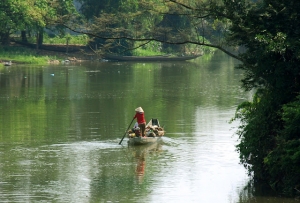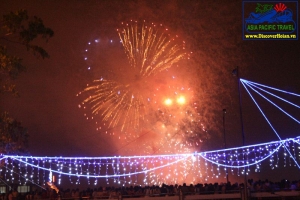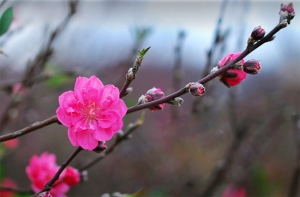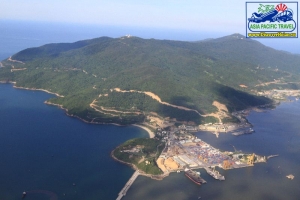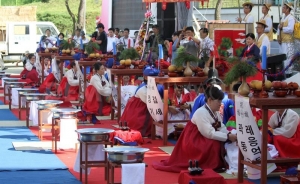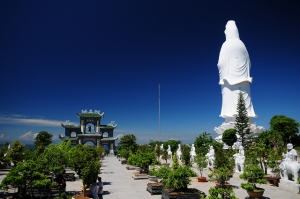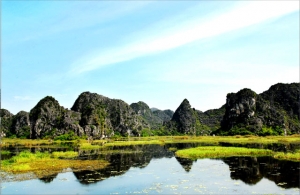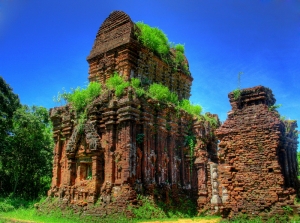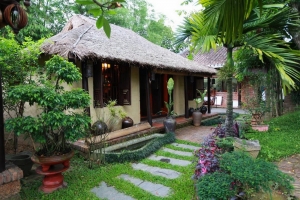
Asia Pacific Travel Team
One day boating along O Lau River
The boat then arrived at the junction of O Lau and Thac Ma rivers. These two rivers flow from the west of Phong Dien District to the east, crossing National Highway 1A at Cau Nhi Bridge on the O Lau River and My Chanh Bridge on the My Chanh River and meeting in Hai Lang in Quang Tri Province. From there, the river receives O Giang and Vinh Dinh tributaries before pouring into Tam Giang Lagoon, which is renowned nationwide.
We sailed down the O Lau River. Along the banks are peaceful wharves shaded by bamboo clusters, here and there dotted with lotus ponds. The more we traveled down, the narrower the river became.
Our boat arrived in Van Trinh where the O Lau River meets the Vinh Dinh River before flowing into Tam Giang Lagoon. At the section the river became wider, tourists could hear bustling sound from fishing boats of the residents of Tam Giang Lagoon from afar.
Our boar sailed to Dai Loc where a big market used to be formed in the old days by traders along this waterway network between Hue and Quang Tri. Leaving Van Trinh, we traveled along the O Giang River to the low-lying area of Hai Lang with thousands of hectares of paddy fields deeply flooded all year round. The scene reminds travelers of the flooded season in the Mekong Delta. The only difference was the Truong Son Mountain Range to the west. On the emerging ridges amidst the flooded areas were houses and gardens of local people.
We saw immense rice fields along the banks and the bell tower of a church. The boat came ashore in front of a big, beautiful church in Cay Da Village in Hai Lang District. Inside Cay Da Church is a school set up by parish priest for local children.
Returning along the O Giang River, we got back to the O Lau River. On one bank are Ha Lo and Cau Nhi villages while Luong Dien Village is on the other bank. We returned to the junction, where the promontory in the shape of a turtle’s head is considered the holy land of Cau Nhi Village, and went back to Hoi Ky Village where we had started the boat tour.
Da Nang to host 7th international firework competition
Themed “Da Nang – A symphony of Colours”, the event is expected to feature spectacular performances by five teams from the US, South Africa, Australia, Poland and the host Viet Nam , who won numerous awards at other international fireworks display competitions.
Many sideline activities will be held during the event, including a food festival, decorative lighting, a flower boat parade and beach sports.
According to the organising board, the Da Nang International Fireworks Competition will be advertised on StarWorld, National Geographic and BBC Asia.
Launched in 2008, Da Nang is the only city in Viet Nam to host the annual competition.
Vietnam Airlines carries apricot, peach blossoms for Tet Festival
A passenger will be allowed to check in with one branch of apricot or peach blossoms, measuring maximum 150cm x 40cm x 40cm as a special ‘Luggage Consignment Service’.
Transportation fees will cost around VND275, 000-440,000.
Passengers must register to transport apricot and peach blossoms at least 3 hours before departure time.
The low-cost airline Vietjet will also transport apricot and peach blossoms for Tet from January 15 to March 5. Transportation fee will be VND400, 000.
Passengers can register on the website www.Vietjet.com and the carrier’s booking offices or agents nationwide.
Tourists to Da Nang increase in January
Around 263,000 travellers visited the coastal city last month, up 13.3 percent against January in 2014.
Of them, 112,000 were foreigners, a slight increase of 3.5 percent and 151,000 were local holiday-makers, jumping 21.9 percent from the same period last year.
The revenue also rose 20 percent from one year ago to 765 billion VND (35.832 million USD).
Da Nang recently joined with central Thua Thien-Hue and Quang Nam provinces to unveil a campaign to promote tourism in their central region, home to numerous renowned beaches and world heritage sites.
The programme will focus on introducing new tourism options from all three localities in 2015, including a number of fascinating events, festive activities and tourism packages.
The city will introduce new river tours, the Helio entertainment complex, a French village, the Asia Park, a night market on Han river, Vincom commercial centre, and more.
Korean ginseng festival opens in Ho Chi Minh city
A Korean ginseng festival is set to open at Crescent Mall, Vincom Centre in Ho Chi Minh City from January 31 to February 1.
The event, co-organised by Geumsan prefecture and Korean ginseng company, is a golden opportunity for Vietnamese customers to taste free food from Ginseng and benefit from incentives and attractive discounts up to 30%.
Visitors will also have a chance to enjoy a wide range of art performances, attend interesting games, and meet with Korean and Vietnamese singers at the festival.
In the framework of the event, a seminar on Korean Geumsan ginseng will be held at New World Hotel, district 1, on January 30.
Quan The Am Festival in Da Nang
The annual festival held at the Quan The Am Pagoda is one of the area's leading cultural events, calling upon crowds of up to 10,000 visitors in past years.
The main festival, which falls on the 19th of the second lunar month, includes many activities such as calligraphy, tea drinking, drum and local dance performances, a painting exhibition, a boat race and a folk music performance of bai choi (a card game in which players sitting in a hut simultaneously play and sing).
Long Thanh Folk Show - New tourism place in Hanoi
A new show combining Cheo (traditional opera) and Water Puppetry is currently being staged daily between 5.30 and 6.30pm at the Ha Noi Cheo Theatre, 15 Nguyen Dinh Chieu Street.
Entitled "Long Thanh Dien Xuong" or the Thang Long Citadel Singing Show, the act features folk dances, traditional opera, Xam singing (folk music performed by blind beggars), and Chau Van (chamber singing performed through trance rituals in honour of Mother goddesses), which are either illustrated through or mixed with Water Puppetry.
![[IMG]](http://i.imgur.com/ZzR8AeL.jpg)
![[IMG]](http://i.imgur.com/yQfK60c.jpg)
![[IMG]](http://i.imgur.com/tugsgYi.jpg)
![[IMG]](http://i.imgur.com/Eaa3Zdv.jpg)
![[IMG]](http://i.imgur.com/wpnSWXz.jpg)
![[IMG]](http://i.imgur.com/pRtiLvm.jpg)
![[IMG]](http://i.imgur.com/lCIJ7Vb.jpg)
![[IMG]](http://i.imgur.com/7PnBnMA.jpg)
![[IMG]](http://i.imgur.com/2tP4D7D.jpg)
![[IMG]](http://i.imgur.com/nSKizpd.jpg)
![[IMG]](http://i.imgur.com/n7ulE5F.jpg)
Vietnamtourism.info
Ninh Binh opens National Tourism Year 2015
The exhibition, which runs January 22-24, is part of activities celebrating the designation of the Trang An Scenic Landscape Complex as a UNESCO mixed natural and cultural heritage of the world.
Trang An Scenic Landscape Complex Director Nguyen Duc Long said the complex is the first site in Viet Nam to receive the mixed natural and cultural heritage status.
The exhibition is divided into eight areas exhibiting artefacts, artwork and other items pertaining to Viet Nam’s eight world heritages – Thang Long Royal Citadel, Ha Long Bay, Ho Dynasty Citadel, Hoi An old quarter, My Son Sanctuary, Trang An Scenic Landscape Complex, the Hue imperial relic complex and the Phong Nha-Ke Bang National Park.
Long added that the exhibition provides a good opportunity for exchange and sharing experiences of managing, conserving and developing cultural values among cities and provinces throughout the country.
India restores My Son Sanctuary site
The activity will be carried out according to the memorandum of understandings about the preservation and restoration of My Son Sanctuary world cultural heritage site signed between Viet Nam and India in 2014.
According to Dinh Hai, Director of the Quang Nam provincial Department of Culture, Sports and Tourism, the Government of India will provide USD2.5 million to assist Vietnam in restoring and preserving the heritage site.
The project will be carried out in five years. India will provide pecialists as well as necessary equipment and materials for the restoration and preservation efforts./.
Phuoc Tich Ancient Village
Built in 1470 under the reign of King Le Thanh Tong, the village was recognized as a national relic by the Ministry of Culture, Sports and Tourism in 2009. Being associated with Hue’s royal music (nha nhac), the ancient village of Phuoc Tich has been recognized as part of the world’s intangible cultural heritage by the United Nations Educational, Scientific and Cultural Organization (UNESCO). Phuoc Tich Ancient Village is famous for the ancient architecture and design of its many old houses and temples.
More than 500 years of existence, through the wars and the devastation of nature, Phuoc Tich village still preserves the ancient beauty of a traditional Vietnamese village.

The village’s first name is “Phuc Giang”, expressing the desire a land near river with happiness and wealth. Under Tay Son era, “Phuc Giang” was changed into “Hoang Giang” to commemorate the family setting up the village. In the reign of Gia Long King, the village was renamed to Phuoc Tich, hoping to accumulate happiness and virtue.
One of special stop to visit at Phuoc Tich may be Cay Thi Temple, which is about 700 years old. The temple preserves harmonizing features of Vietnamese and Cham architecture, with linga and yoni ruins.
Being well-known nationwide for the craft of making pottery, the beauty of Phuoc Tich pottery products is solid, sleek and sophisticated.

The goods have a dark red colour of baked clay, which have been used mainly by Hue families. Some pottery wares of Phuoc Tich Village were used by kings in the Nguyen Dynasty.Between 1989 and 1995, the pottery craft of Phuoc Tich seemed to come to a standstill.
The ancient “ruong” houses, where preserve and display antiquities of Phuoc Tich create the unique Phuoc Tich.
Another unique trait of Phuoc Tich is the structure of “community house”. The houses were built with a typical architectural style of three compartments and two lean-tos, an ancient gate, two rows of green tea bushes and a brick-covered courtyard, most of which remain undamaged despite having gone through so many wars throughout the years.


